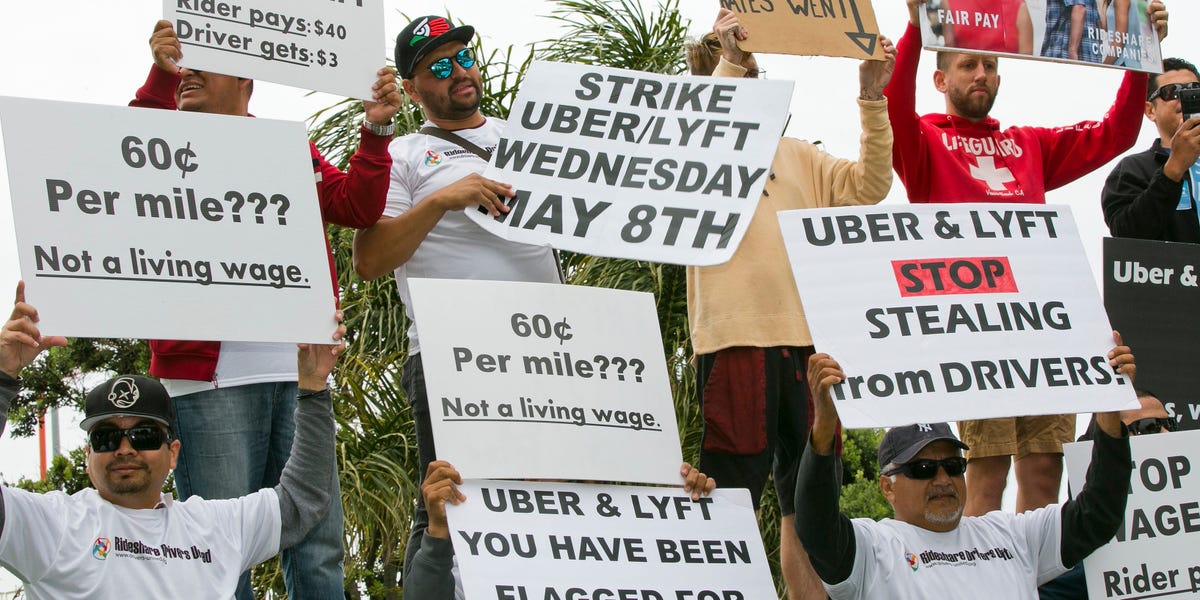- The Minneapolis City Council is considering an ordinance that would boost Uber and Lyft drivers’ pay.
- Supporters say it will ensure drivers earn at least the city’s minimum wage of $15.57 an hour.
- Uber and Lyft have threatened to leave the city if the ordinance passes.
Thanks for signing up!
Access your favorite topics in a personalized feed while you’re on the go.
download the app

Minneapolis is at the center of the debate over two key questions facing the ride-hailing industry. How much money do Uber and Lyft drivers make? And what minimum pay should they be guaranteed?
The conversation around ride-hailing driver pay has been heating up across the country over the past year. Several Uber and Lyft drivers told Business Insider that ride-hailing is less profitable than it used to be, with many of them pointing to the rollout of the “up-front fares” programs and high driver supply as key reasons. On Valentine’s Day, some drivers took part in a nationwide protest to raise awareness about concerns regarding driver pay, safety, and deactivations.
At the heart of the tensions between drivers and ride-hailing companies is a disagreement over how much drivers really make in profits. Drivers say Uber and Lyft’s earnings estimates don’t adequately account for vehicle expenses like gas and maintenance, in addition to the time they spend between trips driving to a passenger or relocating to a busier area.
“The workers who rely on Uber and Lyft as their primary source of income typically find it very hard to make ends meet,” Erin Hatton, a professor of sociology at the University at Buffalo, told Business Insider. “The hidden costs of this work add up and the income is uneven and unstable.”
On March 7, the Minneapolis City Council passed an ordinance by a 9-4 vote that would require ride-hailing companies to pay drivers $1.40 per mile and $0.51 per minute when a rider is in the vehicle — and guarantee earnings of at least $5 each trip, excluding tips. These standards would only apply to trips within the city.
Minneapolis Mayor Jacob Frey, who had advocated for lower pay guarantees of $1.20 per mile and $0.35 per minute, vetoed the ordinance on March 8. But the council could have the nine votes needed to override the veto — the vote is expected to be held on March 14.
Uber and Lyft have threatened to pull their businesses out of Minneapolis if the ordinance is passed and implemented on the designated deadline of May 1. Lyft said the city’s proposal would nearly double fares for riders, which could reduce demand and ultimately make drivers worse off.
“Should it become law, Lyft would be forced to cease operations in Minneapolis and possibly the rest of the state when it takes effect,” Lyft said in a statement provided to Business Insider.
Uber told BI that it will be forced to exit its ride-hailing business in Minneapolis if the proposal takes effect.
“If this ordinance is enacted, we look forward to working with drivers, riders, and the legislature to bring rideshare back,” a company spokesperson said.
Would Uber and Lyft really ditch Minneapolis?
Minnesota isn’t the first place that’s taken steps to address drivers’ concerns. New York City, Washington, and California have adopted minimum pay rates for drivers, and proposals are under consideration in Chicago and Massachusetts. The statewide standards Washington enacted in 2022, for instance, guaranteed that Seattle drivers would earn $1.38 per mile, $0.59 per minute, and a $5.17 trip minimum — comparable figures to those in the proposed Minneapolis ordinance.
While Uber and Lyft haven’t exited markets like Seattle, the companies have said adopting pay levels like Seattle’s in Minneapolis would be unsustainable for customers and drivers. The companies have argued that Seattle’s residents are better financially equipped to accommodate rising fares. In the same vein, the cost of living is higher in Seattle, so its drivers are arguably in need of higher guaranteed pay.
But there could be another reason Uber and Lyft have pushed back particularly hard in Minneapolis. Washington state’s legislation stipulated that drives would remain independent contractors — not employees of the companies — which ensured the ride-hailing behemoths wouldn’t be on the hook for things like health insurance and overtime pay. Minnesota lawmakers aren’t interested in including a similar stipulation, Axios reported.
If the ordinance passes, it remains to be seen whether Uber and Lyft will ultimately pull out of the city, Alexandrea Ravenelle, assistant professor of sociology at the University of North Carolina, told Business Insider.
“It’s a common threat for these platforms to say that they will leave a market,” she said. “But it turns out that even when they start to finally pay workers a better wage, they’re still fine.”
Sergio Avedian, an Uber driver and a senior contributor at the gig-driver-advocacy blog and YouTube channel The Rideshare Guy, told BI he thinks Uber and Lyft’s threats are a “bluff.” He said the companies have threatened to leave markets in the past but that the only time they did so was in 2016, when Austin began requiring ride-hailing companies to conduct fingerprint background checks on drivers.
Uber and Lyft returned to the market in 2017 when these requirements were eased, but Avedian said the ride-hailing app Ride Austin was able to operate in the interim successfully.
Still, some Minneapolis drivers are concerned about the possibility of losing the ride-hailing companies — which have provided many of them a valuable source of income.
Joe Pierce, an Uber and Lyft driver in Minneapolis, told BI that both the mayor’s and city council’s proposals could make a huge difference to drivers. However, he’d be willing to accept a more modest victory if it kept Uber and Lyft in the city.
“Any driver would say, ‘Yes, give us $1.40 per mile and $0.51 per minute please,'” he said. “But I think at a certain point we have to be realistic.”
Loren Balazs, a full-time driver in Minneapolis, told BI he’s worried the city council’s proposal would hurt his ride-hailing business.
“I did the math and it will raise fares 70% to 100% and upset supply and demand in Minneapolis,” he said. “Not to mention Uber and Lyft might not be bluffing.”
Some organizations have also raised concerns about the impact of rising fares on low-income individuals and people with disabilities who rely on ride-hailing services.
“This is more multi-dimensional than a one-side vote about driver wages,” Sheri Wegner, executive director for the nonprofit ConnectAbility, which serves people with disabilities in Minnesota, told the Star Tribune.
The impact of Uber and Lyft’s departure would also affect the drivers, many of whom rely on ride-hailing as an important source of income. Some of them are planning on driving for the city’s taxi services as their backup plan.
Whether they’ll ultimately lose their ride-hailing gigs is very much in question, Avedian said.
“Forty-five days is a long time — things can happen,” he said, referring to the May 1 deadline. “Let the games begin.”
The question of how much drivers really make has fueled the debate
The city council’s ordinance was designed to ensure drivers earn at least Minneapolis’s minimum wage of $15.57 an hour after factors like vehicle expenses are subtracted.
A state-commissioned study released on March 8 found that in 2022, drivers in the Twin Cities metro area earned $13.63 an hour after expenses. The study estimated that a minimum pay rate of $1.21 per mile and $0.49 per minute would guarantee drivers earned the city’s minimum wage.
“The proposal the council put forward was wrong,” Mayor Frey said in a news conference on Tuesday. “Their stated position was that this was a way to get rideshare drivers to a minimum wage. In fact, there is a substantially lower rate that will both get drivers a minimum wage and will have expenses covered.”
Uber and Lyft took issue with the way the study calculated driving expenses. Uber called the study “deeply flawed;'” Lyft said much of it was “nonsensical.”
Uber told BI that it supports a statewide minimum earnings guarantee in Minnesota of $35 per active hour — the time between when a ride is accepted and completed — before driving expenses. Lyft said it would support a statewide guarantee that would allow it to “sustainably and affordably operate for riders.” In February, Lyft said the typical US driver earns about $23 per active hour after expenses. In November, Uber said the typical driver earns $33 per active hour before expenses.
The debate over minimum pay for ride-hailing drivers has been building in Minneapolis for over a year. Last May, Minnesota Gov. Tim Walz vetoed a bill that would have established minimum pay standards for Uber and Lyft drivers. In August, the Minneapolis City Council passed a similar ordinance by a 7-5 vote, but an effort to override the veto failed.
In the past year, Uber and Lyft have started paying drivers at least $5 per ride for all trips within Minneapolis. But supporters of the ordinance say they haven’t gone far enough.
Are you a gig worker willing to share your story about pay, schedule, and tipping? If so, reach out to this reporter at jzinkula@insider.com.


